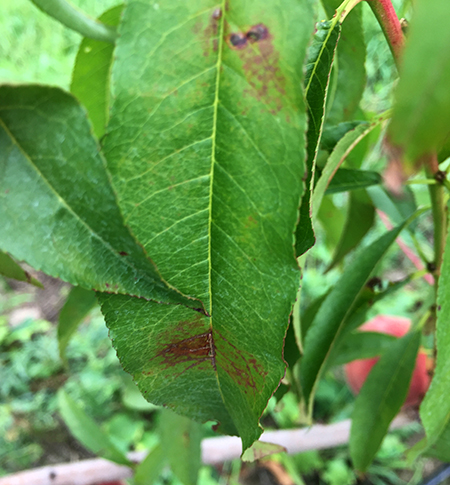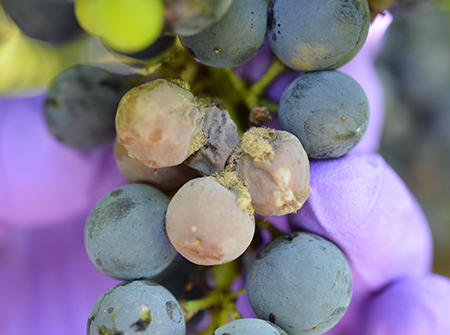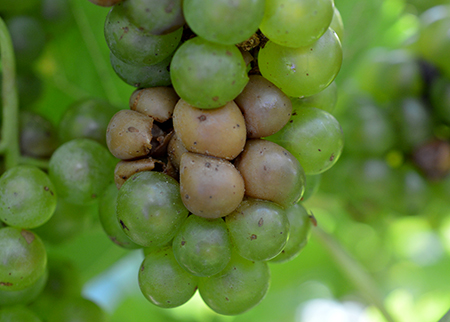Southwest Michigan fruit update – Aug. 28, 2018
Peach, apple, pear and plum harvest continues. Blueberry harvest is ending.

Weather
Last week was relatively cool with highs in the 70s and lows in the 50s. These temperatures are in the normal range for August. The passage of a cold front on Tuesday morning brought rain across the region with rain fall totals ranging from 0.25 to 1.5 inches and cooler temperatures.
The passage of a frontal system on Saturday brought thunderstorms and scattered rain. It also brought much warmer and more humid conditions for Sunday into this week. Southwest Michigan missed the storms that crossed northern Michigan Sunday and Monday, but get storms and rain Tuesday. Rainfall totals for the season are about 21 inches for the region.
Weather for the upcoming week should be cooler by mid-week with highs in the 70s. Labor Day weekend will be warmer with a chance for rain.
|
Southwest Michigan GDD summary from March 1 – Aug. 27, 2018 | |||
|---|---|---|---|
|
Station |
GDD 42 F |
GDD 45 F |
GDD 50 F |
|
Benton Harbor (SWMRC) |
3,350 |
2,957 |
2,331 |
|
Lawton (Lawton) |
3,370 |
2,976 |
2,346 |
|
Fennville (TNRC) |
3,210 |
2,826 |
2,215 |
|
Average for the SW region |
3,355 |
2,962 |
2,335 |
|
Accumulation last week |
162 |
144 |
113 |
Tree fruit
San Jose scale trap catches continue to decline. Apple maggot numbers are down for the second week. Insecticide choices should include materials effective against apple maggot. Brown marmorated stink bug (BMSB) numbers continue to be relatively low compared to last year at this time. Spotted wing Drosophila (SWD) numbers continue to be high.
Peach and nectarine varieties being harvested now include Cresthaven, PF23, Glowingstar and PF24C. Sugar content has improved with the drier conditions. Peach scab and brown rot are easy to find on fruit of susceptible varieties with weak fungicide programs. Leaf drop of older leaves due to bacterial spot infection is common on susceptible varieties.

The red marks on this peach leaf are caused by the leaf tip of the leaf on the left rubbing across the lower leaf in the center in the wind. Photo Bill Shane, MSU Extension.
Oriental fruit moth numbers declined this week compared to last week. This is the third generation flight. Growers who deployed pheromone disruption for oriental fruit moth around bloom time may see increased pressure from this insect as the lures start to wear out. Sprayable pheromones are available to extend the period of control.
Peaches are especially attractive to brown marmorated stink bug, causing white regions of slightly firmer, disorganized peach flesh close to the skin.
Cherry defoliation by cherry leaf spot continues. Maintain fungicide protection to preserve the remaining leaves.
Plum harvest of Castleton, Fortune NY6 and some Stanley is underway. Continue protecting against brown rot. Protect ripening plums against apple maggot. Apple maggot numbers are declining in the Trevor Nichols Research Center trap line. Codling moth and oriental fruit moth can also attack plums. SWD can attack plums as they ripen. Plums become susceptible when they soften.
Apple maturity can be monitored using iodine solution to test for starch conversion on the Cornell University scale. Growers with a light crop or with bitter pit-susceptible varieties should include calcium in their cover sprays to reduce bitter pit. In orchards where apple scab is present on fruit and leaves, consider beefing up fungicide coverage shortly before harvest to help prevent pinpoint scab showing up in storage.
Weather conditions over the past two weeks have been only moderately favorable for sooty blotch and fly speck. Reapply fungicides for these two diseases whenever the hours of leaf wetness exceed 250 since the last fungicide application.
Black rot, frogeye leafspot and rust leaf spot symptoms are common in apple plantings where fungicide protection is inadequate. Salmon colored spores of bitter rot can be found on apple fruit rot spots. Light colored fruit such as Honeycrisp and Empire are more susceptible than darker varieties.
European red mite levels have reached leaf bronzing levels, especially where pyrethroids have been used. This pest begins to lay winter eggs in mid- to late August. Scout for eggs in the calyx of the fruit and treat hot spots with a miticide. Catches of oriental fruit moth and codling moth have risen in many orchards. Obliquebanded leafroller are laying eggs. Apple maggot trap catch numbers are low after a strong flight earlier in August.
In pears, Bartlett harvest is underway. Black leaf caused by European red mite feeding are being noticed. Pear fruit become attractive to codling moth attack when they soften in August. Pears need to be protected from the second generation flight, which is occurring now.
Small fruit
Grapes are finishing veraison. Most berries are soft and well colored. We are seeing increased powdery mildew and downy mildew on the leaves, but at this point in time the fruit are resistant. Downy mildew becomes a serious problem in late summer and fall when we have heavy morning dews. Susceptible varieties need to be protected to preserve the leaves and ripen the grapes. Botrytis and sour rot symptoms are apparent in damaged wine grape clusters.

Botrytis fruit rot in a Chancellor cluster. Photo by Keith Mason, MSU.

Sour rot in a cluster of Vignoles. Photo by Keith Mason, MSU.
Third generation grape berry moth are still flying but egglaying is declining. We are seeing active feeding, especially along the wooded vineyard edges. Check vineyards and consider controls of the fourth generation. The MSU Enviroweather Grape Berry Moth model predicts egglaying by the fourth generation to begin between Aug. 29 and Sept. 1 in Van Buren and Berrien counties, and around Sept. 4 in Allegan County. Due to long pre-harvest intervals, insecticides with good contact activity may be the best option.
The number of SWD flies keeps increasing. We are seeing SWD and other vinegar flies in clusters with split or damaged berries. Be mindful of SWD and vinegar fly infestation as harvest nears and more split berries occur. We seeing brown marmorated stink bug (BMSB) in vineyards, but no signs of feeding. Look for this insect until harvest.
Blueberry harvest is winding down quickly. Growers closer to the Lake and further north are harvesting late varieties. Many growers finished early because of a light crop in later season varieties. Growers with fruit are applying fungicides and insecticides to protect ripening fruit against fruit rots and spotted wing drosophila (SWD).
SWD numbers are high. Maintain irrigation if rainfall is sparse. This will maintain bush health and set a good crop of flower buds for next year. During the late summer, blueberry fields need an inch of water a week. Some growers are pruning while labor is available.
Strawberries are putting out runners. Protect fields from leaf diseases and potato leafhoppers, which stunt plant growth. Maintain irrigation to assure good yields next year. Day-neutral berries are blooming again and fruit is being harvested. Ripening strawberry fruit need to be protected from SWD and harvest as frequently as you can to minimize the amount of time the fruit is available to the fly.
Bramble harvest continues with fall raspberries. Raspberry are a preferred host for SWD and the fruit always needs to be protected.
Upcoming meetings
The Annual Trevor Nichols Research Center Field Day is Tuesday, Sept. 25, 2018, from 1 to 4 p.m. at the Trevor Nichols Research Complex west of Fennville, Michigan.
Related articles
- Michigan State University Spotted Wing Drosophila website
- Southwest Michigan fruit update Aug. 21, 2018
- Control of American brown rot
- Post-harvest cherry leaf spot applications
- Using the MSU Enviroweather grape berry moth model in 2018
- Irrigating Michigan blueberries
- Blueberry weed control: late spring and summer options



 Print
Print Email
Email

